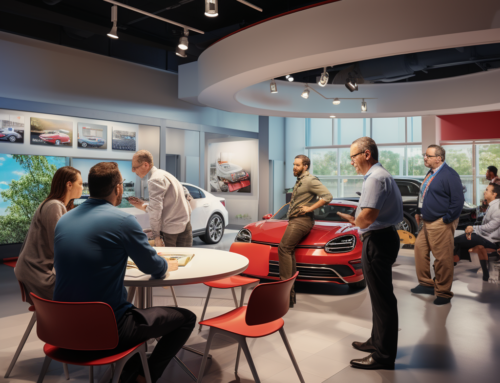In automotive innovation, the strategic selection of C-level executives is pivotal in steering companies toward success and relevance in a swiftly changing landscape. The ability of these top-tier leaders to drive forward organizational strategies, instill a culture ripe for innovation, and navigate the complexities of emerging technologies shapes the foundation of industry advancement. With the accelerating demand for revolutionary solutions in electric vehicles, autonomous driving, and connectivity, the significance of recruiting C-level automotive talent with a sharp industry focus and a penchant for groundbreaking ideas becomes ever more pronounced. The impact of these executives reverberates throughout the industry, setting the stage for a compelling narrative of progress and achievement.
Strategic Impact of C-Level Recruitment
The strategic impact of C-Level recruitment on organizational innovation and success levels cannot be understated in the dynamic landscape of the automotive industry. Executives at the C-Level are pivotal in driving innovation, setting strategic objectives, and cultivating a culture of innovation within their organizations. The ability to attract top talent to these positions is crucial for staying ahead in a rapidly evolving market where new technologies and consumer demands constantly reshape the industry.
Effective C-Level recruitment goes beyond filling positions; it is about finding individuals who possess the necessary technical skills and bring a strategic vision and a passion for innovation. These leaders play a significant role in aligning innovation initiatives with the company’s overall strategic direction, ensuring that resources are allocated efficiently and the organization remains competitive.
Cultivating Innovation Through Leadership
Elevating automotive innovation hinges on cultivating a culture of creativity and risk-taking through visionary leadership at the C-Level. Effective executive leadership talent is crucial in driving innovation efforts within automotive companies. To delve deeper into this topic:
- Visionary Leadership: C-Level executives are instrumental in setting a forward-thinking vision that guides innovation efforts and inspires teams to think outside the box.
- Culture of Innovation: C-level executives can cultivate a culture where innovation thrives by fostering a work environment that encourages experimentation and learning from failures.
- Talent Acquisition: Recruiting top-tier leadership talent with a proven track record of driving change and embracing new technologies is essential for staying ahead in the competitive automotive landscape.
- Empowering Intrapreneurship: C-level executives play a key role in supporting intrapreneurship within their organizations, empowering employees to explore new ideas and drive innovation from within.
Through the strategic guidance and unwavering commitment of C-level executives, automotive companies can create a dynamic environment where innovation flourishes, propelling them toward future success in the industry.
Industry Expertise and Technological Vision
How can industry expertise and technological vision synergize to propel automotive innovation to new heights? In the realm of C-Level recruitment within the automotive industry, the fusion of industry expertise and technological vision is paramount for driving innovation. Executive search specialists in automotive recruitment seek individuals with a deep understanding of the sector’s nuances, including dealership group dynamics and the intricacies of automotive-related businesses. These experts also prioritize candidates with a forward-thinking technological vision capable of navigating advancements such as electric vehicles, autonomous driving, and connected technologies.
Successful C-Level recruitment hinges on identifying leaders who bring industry-specific knowledge and demonstrate a keen insight into the future of automotive technology. By leveraging a nationwide network of top-tier talent, recruitment professionals ensure executives appointed to key positions are equipped to spearhead technological advancements and foster a culture of innovation within automotive organizations. The strategic alignment of industry expertise and technological foresight through C-Level recruitment propels automotive companies towards sustained growth and competitiveness in an era of rapid technological evolution.
Measuring Innovation Leadership Effectiveness
Successful automotive CXOs who have driven transformative innovation in the industry showcase the importance of measuring innovation leadership effectiveness through various key indicators and evaluation criteria. Chief operating and financial executives need to implement robust methods for assessing the impact of leadership on innovation within their organizations. By analyzing financial metrics, customer satisfaction levels, employee engagement, innovation outcomes, and market share, executives can gauge the effectiveness of their leadership in driving innovation. Key indicators such as financial performance, innovation outcomes, customer feedback, and employee motivation play a crucial role in evaluating the success of CXO leadership. Evaluation criteria encompass strategic alignment, innovation success, organizational growth, and market competitiveness. Quantitative measures like revenue growth, new product launches, employee retention, market expansion, and qualitative factors are essential in determining leadership effectiveness. Effective innovation leadership is characterized by the ability to inspire creativity, drive change, foster collaboration, and achieve sustainable business growth.
Conclusion
In conclusion, recruiting top-tier C-level executives in the automotive industry is critical in driving innovation and maintaining a competitive edge. According to a recent study by McKinsey, companies with strong C-level leadership are 50% more likely to outperform their competitors in revenue growth. By attracting and onboarding executives with specialized industry knowledge and a commitment to innovation, automotive enterprises can position themselves for sustained success in a rapidly evolving landscape.





